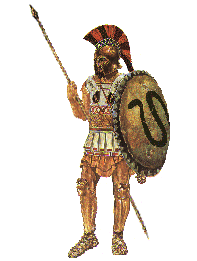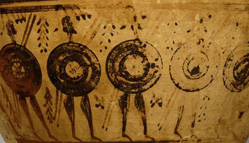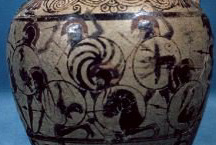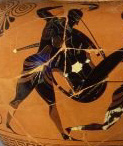
Welcome to Luke's Library of:
Classical Greek Shield Patterns



This page last modified: October 17, 2000

Most of the shields shown here are "hoplons", a few are peltas or similar, there are also a few parablemata (shield aprons); unless noted all are carried by warriors on foot rather than mounted. I use "Greek" in a wide sense including Greek-influenced Italian states such as Campania, from where most late 4th century depictions of hoplons come from.
The word hoplon did not actually come to mean the peculiar shield associated with hoplites until the end of the 5th century, and even then it was still more often referred to by the more generic name "aspis".

|
|
Generally, each hoplite chose his own shield design. This was true even of the Spartans, at least initially. There is an anecdote which talks of a Spartan who had a life-sized fly for his emblem. Accused of cowardice (his enemies wouldn't be able to recognise him) he responds that the fly would be the size of a lion when he bore down on his enemy in battle. However, they changed this personal-preference policy into one of state control, whereby each man carried the same badge - in this case the letter lambda (for Lakedaimon, another name for Sparta). Such shields are attested by Xenophon in the early 4th century BC. He also mentions men from Sicyon carrying the letter sigma as a badge, and the Thebans, as well as their allies, using a club, although the Thebans had used individual shield designs only a few years previously as shown by Plutarch: the man who killed Lysander had a dragon as his emblem. While such state badges seem to have become more common as time went on - the Macedonian Hellenistic states seemed to have regular shield patterns, many states continued with allowing their men to chose whatever badge they desired. One philospher's was covered with quotes, another man's had the device of an anchor to demonstate his determination not to retreat.
It is widely assumed that Sparta was the first state to introduce uniform shield patterns, but the evidence does not bear this out. The Mantineians may have adopted the trident of Posidon by the mid 5th century as there is a refrence in Bacchylides to it. My own theory is that Spartans first introduced the lambda not for Homoioi (full citizens), but for helots that were serving as hoplites, and its usage probably spread from there to the rest of the army. Shield blazons were an individual's perogative, but when helots were armed as hoplites, they would have been provided with their shields by the state, not have bought them individually. The shields in fact would have been state propetry, not theirs, and therefore are likely to have been embalzoned with an emblem of the state. This would emphasize that the bearers were not individual citizens, but servants of the state (although, like Brasidas' men, they could be manumitted later for good conduct as Neodamodeis).
Since many of the works I consulted had black and white illustrations, colours are often my guesses only; and besides, a red-figure vase is likely to show only red and black colours anyway (with a possibility of white and purple), since the technique of producing red-figure vases precluded other colours. Incidentally, I have used the terms 'Attic' and 'Athenian' interchangeably. No distinction is intended. One further point - a shield described as eg. 'Corinthian' may not necessarily actually be Corinthian - it just happens to be depicted on a Corinthian-style vase.
For those of you that can't be bothered with painting fiddly designs on your hoplons, but still want them to look good, there's a British outfit called Veni Vidi Vici that specialise in making transfers for shields. Greek patterns (and many others) are available in both 15mm and 25mm scales. They have a web-page showing all their designs and are well worth getting, especially given the reasonable prices. They now even sell sheets with mixed patterns on, so you don't have to buy lots of the same design.
If you have access to a colour laser printer, an alternative is to print my designs out yourself. Here's how Mike Manning's said he's done this:
"I've copied the images into a word document and scaled the shields to be precisely the same as my 20mm Nexus Greek hopilite shields and printed them out on a colour laser printer (if memory serves, a straight print of your site yields shields of 16.5mm. My Nexus Greeks have shields of 12.5mm so 25% reduction was perfect). I cut them out and put an inconspicuous slit from the lower right corner to the center. This is to allow the flat paper to conform to the convex shield. The result is quite nice and it has cut the time it takes to produce 16 hopilites by 60%!
The copy paper we use in the printer at work is 20lb bond, which is a little heavy but I found that soaking the reverse of the shield in diluted white glue softens it enough to allow the paper to conform to the shield. If you can find 10lb bond it would be preferable for an ink jet printer but I doubt it would survive the tortuous feed path of most laser printers".

The origins of the the hoplite phalanx formation and the unique shield that went with it are somewhat obscure. (The shield is unique in its concavity making a shoulder rest that could be used to take some of its great weight, and not in it's double grip nature, which is in fact a common design feature of many types of shield stretching over several millenia).

|
One early proto-Corinthian (ca. 700 BC) pottery depiction shows figures looking like 'hoplites', ie. armoured spearmen carrying large round shields, alongside other lighter warriors with the Geometric-period 'dipylon' shield that is usually depicted slung on its bearer's back. It seems that the 'Argive' shield (as the hoplon was frequently called by Classical sources) was therefore introduced before the phalanx rather than vice versa - it seems unlikely that dipylon-bearing warriors would, or could fight in a rigid phalanx. However, once the phalanx was introduced, it spread rapidly: even Greek states in Asia that were previously cavalry powers, such as Colophon, had made the transition by ca. 650 BC.
|
|
Despite this, figures looking like 'hoplites' are depicted even slightly before this date, such as those shown immediately above, although unlike later hoplites, they carry a pair of spears/heavy javelins. As the phalanx developed, the secondary missile weapon eventually became redundant, since it could not be used from within the confines of a rigid phalanx, a process that took some time: the famous Chigi vase of 640 BC shows the fully-developed phalanx in operation, although each hoplite still carries a second spear, as do the warriors of another Protyocorinthian aryballos from the same date, now in the London Museum, and shown to the right.
|

|
It is possible that the Argive tyrant Pheidon was responsible for the rapid spread of the phalanx. In the early 7th century BC, he held sway over most of the Peleponese, defeating the Spartans, whom did not at that time fight in a phalanx; as Tyrtaeus' poetry makes clear, the Spartan warriors of his day frequently hurled javelins and stones, and fought interspersed with psiloi (light infantry), and at least some used shields that reached down to to the ankle.
What sort of shields these were is problematic - the huge cow-hide 'tower' and 'figure-8' shields of the Mycenaean period had fallen out of use many centuries before, to be replaced by light peltas such as shown on the famous 12th century 'Warrior Vase'. After that, the Geometric period saw the widespread use of the 'dipylon' shield - a light basket-work shield slung on the bearer's back with large cut outs so that the elbows would not be obstructed. This shield, used by infantry, cavalry and charioteers alike, is altogether too small to reach the ankle. Unfortunately, as far as I know, no early 7th century depictions of suitably long shields exist.

|
I would postulate that a possible candidate is the 'Boeotian' shield often illustrated on 6th-century black-figure vases. This is something like a cross between a hoplon and a dipylon shield, perhaps similar to the Persian gerrhon, longer than it is wide (which would incidentally make it a better bier to carry away the fallen). Such shields are invariably shown in a mythical context, but must have had some factual basis. Perhaps they are a 6th century memory of more 'heroic' (ie. individualised) combatants a hundred years before, from the time when the phalanx was in the ascendency, but not yet totally ubiquitous.
To the left is an Attic Black Figure depiction of a warrior from a Neck Amphora dating from ca. 535 BC. His shield is depicted in a style similar to contemprary hoplons, with double-grip, and bronze rim. |

Return to my homepage index